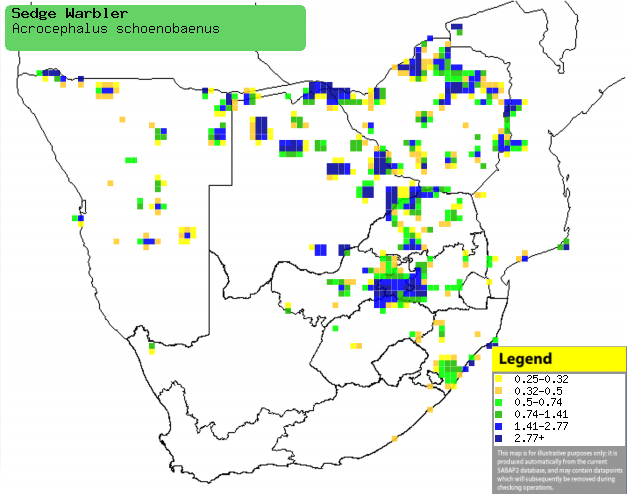|
Acrocephalus schoenobaenus
(Sedge warbler, European sedge-warbler)
Europese vleisanger [Afrikaans]; Niini (generic term
for warblers and eremomelas) [Kwangali]; Rietzanger [Dutch]; Phragmite des
joncs [French]; Schilfrohrsänger [German]; Felosa-dos-juncos [Portuguese]
Life
> Eukaryotes >
Opisthokonta
> Metazoa (animals) >
Bilateria >
Deuterostomia > Chordata >
Craniata > Vertebrata (vertebrates) > Gnathostomata (jawed
vertebrates) > Teleostomi (teleost fish) > Osteichthyes (bony fish) > Class:
Sarcopterygii (lobe-finned
fish) > Stegocephalia (terrestrial
vertebrates) > Tetrapoda
(four-legged vertebrates) > Reptiliomorpha > Amniota >
Reptilia (reptiles) >
Romeriida > Diapsida > Archosauromorpha > Archosauria >
Dinosauria
(dinosaurs) > Saurischia > Theropoda (bipedal predatory dinosaurs) >
Coelurosauria > Maniraptora > Aves
(birds) > Order: Passeriformes
> Family: Sylviidae > Genus: Acrocephalus
Distribution and habitat
Palearctic breeding migrant, with breeding grounds
stretching from western Europe to Scandinavia to Siberia. In the non-breeding
season it heads south to sub-Sarahan Africa, where it is widespread, occurring
from Senegal to Ethiopia south to southern Africa. Here it is locally common in
wetlands, especially well vegetated sewerage works. It generally stays in
reedbeds, often including Papyrus (Cyperus papyrus) or weeds and trees at
the waters edge.
|
 |
|
Distribution of Sedge warbler in southern Africa,
based on statistical smoothing of the records from first SA Bird Atlas
Project (©
Animal Demography unit, University of
Cape Town; smoothing by Birgit Erni and Francesca Little). Colours range
from dark blue (most common) through to yellow (least common).
See here for the latest distribution
from the SABAP2. |
Movements and migrations
Individuals gradually arrive in southern from
late October-January, peaking around late November and December.
Departure is more rapid, with most birds leaving from March-April.
Food
It mainly preys upon slow-moving arthropods, gleaning them
from vegetation, or occasionally from the ground or water surface. Before it
migrates it often fattens up with midges.
Threats
Not threatened, although its range has markedly decreased
in central Europe, the cause of which is though to be drought in the Sahel.
References
-
Hockey PAR, Dean WRJ and Ryan PG 2005. Roberts
- Birds of southern Africa, VIIth ed. The Trustees of the John Voelcker
Bird Book Fund, Cape Town.
-
Harrison, J.A., Allan, D.G., Underhill, L.G., Herremans, M.,
Tree. A.J., Parker, V. & Brown, C.J. (eds). 1997. The atlas of southern
African birds. Vol. 2: Passerines. BirdLife South Africa, Johannesburg.
|
